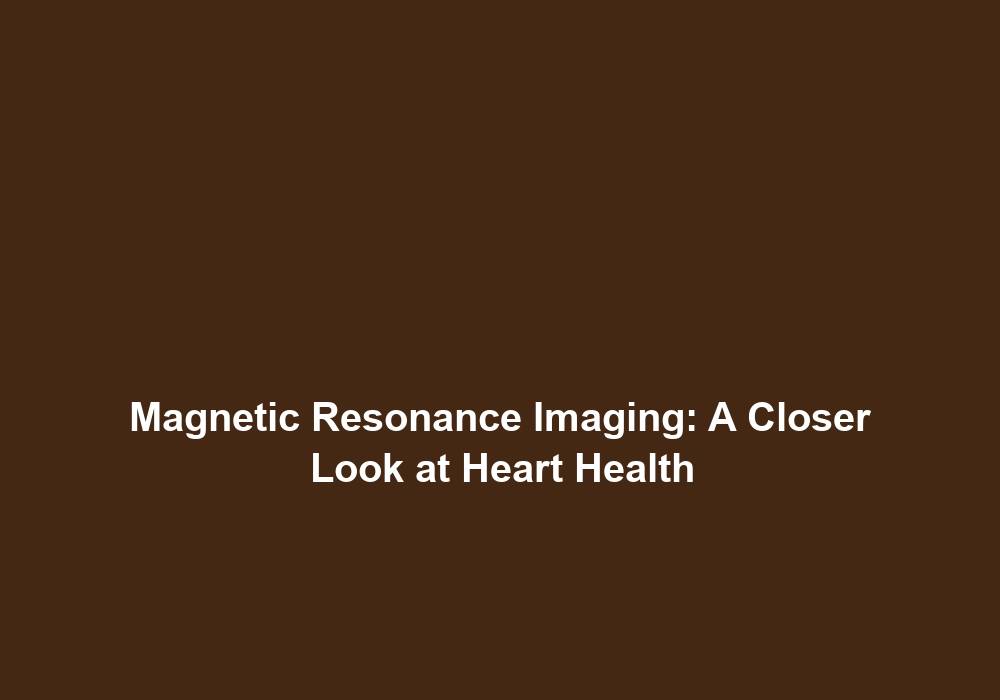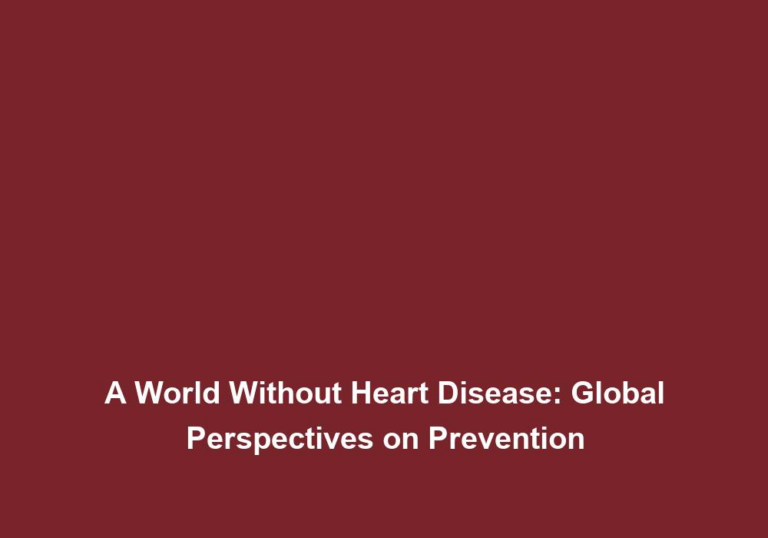Magnetic Resonance Imaging: A Closer Look at Heart Health
Magnetic Resonance Imaging (MRI) is a powerful diagnostic tool that has revolutionized the field of medical imaging. It allows healthcare professionals to obtain detailed and accurate images of the human body, including the heart. In this article, we will delve into the intricacies of MRI and how it helps in assessing and understanding heart health.
Understanding MRI and its Role in Heart Health
MRI is a non-invasive imaging technique that uses a powerful magnetic field and radio waves to create detailed images of various organs and tissues within the body. When it comes to heart health, MRI plays a crucial role in diagnosing and evaluating various conditions and diseases that can affect the heart.
MRI provides a comprehensive view of the heart, allowing doctors to assess its structure and function. By capturing detailed images, MRI enables healthcare professionals to evaluate the size, shape, and overall condition of the heart. It can also help identify any structural abnormalities or defects, such as congenital heart diseases. This information is invaluable in making accurate diagnoses and developing appropriate treatment plans.
Additionally, MRI is instrumental in assessing the function of the heart. It enables the measurement of the heart’s pumping ability, known as the ejection fraction, and the evaluation of blood flow within the heart chambers and vessels. These measurements help healthcare professionals diagnose and monitor conditions like heart failure and valvular diseases. By understanding the heart’s structure and function, doctors can gain valuable insights into a patient’s heart health and make informed decisions regarding their care.
Assessing Heart Structure and Function
One of the primary uses of MRI in heart health is to assess the structure and function of the heart. By capturing detailed images of the heart, MRI allows doctors to evaluate the size, shape, and overall condition of the heart. It can also help identify any structural abnormalities or defects, such as congenital heart diseases.
Additionally, MRI can provide valuable insights into the function of the heart. It enables the measurement of the heart’s pumping ability, known as the ejection fraction, and the evaluation of blood flow within the heart chambers and vessels. These measurements help healthcare professionals diagnose and monitor conditions like heart failure and valvular diseases. By understanding the heart’s structure and function, doctors can gain valuable insights into a patient’s heart health and make informed decisions regarding their care.
In addition to assessing the structure and function of the heart, MRI can also help detect various heart diseases and conditions. It is particularly useful in identifying coronary artery diseases, myocardial infarctions (heart attacks), and abnormalities in the heart muscle. The detailed images provided by MRI can reveal the presence of tumors, masses, or fluid within and around the heart, aiding in the diagnosis and treatment planning.
Moreover, MRI is particularly effective in evaluating the extent of damage caused by heart attacks. It can accurately determine the size and location of the affected areas, which is crucial in developing appropriate treatment plans. By visualizing the damage caused by a heart attack, doctors can determine the best course of action to restore heart health and prevent further complications.
Evaluating Blood Flow and Perfusion
MRI can provide precise information about blood flow and perfusion in the heart and surrounding blood vessels. By utilizing contrast agents, doctors can visualize the blood flow patterns and identify any blockages or abnormalities. This information is critical in diagnosing conditions such as coronary artery disease and identifying areas of reduced blood flow, known as ischemia.
Furthermore, MRI can help assess the perfusion of the heart muscle, which refers to the blood supply to the heart tissue. This evaluation is particularly important in detecting areas of reduced blood flow, indicating potential blockages or narrowing in the coronary arteries. By identifying these issues, healthcare professionals can intervene and implement appropriate treatments to improve blood flow and prevent further complications.
In addition to assessing blood flow and perfusion, MRI can also provide valuable information about the presence of scar tissue in the heart muscle. Scar tissue can develop as a result of heart attacks or other heart conditions, and its presence can have implications for a patient’s overall heart health. By identifying scar tissue through MRI, doctors can better understand the extent of the damage and make informed decisions about treatment options.
Advantages of MRI in Heart Imaging
MRI offers several advantages over other imaging techniques when it comes to assessing heart health. Firstly, it provides high-quality, detailed images that allow for accurate diagnoses. The ability to obtain 3D images further enhances the diagnostic capabilities of MRI, providing healthcare professionals with a comprehensive view of the heart and its surrounding structures.
Secondly, MRI is a non-invasive procedure, meaning it does not require any surgical incisions. This reduces the risks associated with invasive procedures and eliminates the need for prolonged hospital stays. Patients can undergo MRI imaging with minimal discomfort and recover quickly afterward.
Furthermore, MRI does not use ionizing radiation, unlike other imaging modalities such as computed tomography (CT) scans. This eliminates the potential harmful effects of radiation exposure, making MRI a safer option for repeated imaging studies. Patients can undergo multiple MRI scans over time without concerns about radiation exposure.
Preparing for a Cardiac MRI
If you are scheduled for a cardiac MRI, there are a few preparations you may need to make. It is important to inform your doctor about any metal implants or devices in your body, as they can interfere with the magnetic field during the procedure. Examples of such devices include pacemakers, cochlear implants, and metal clips.
You may also be asked to refrain from eating or drinking for a few hours before the scan, as a full stomach can interfere with the imaging process. However, your doctor will provide you with specific instructions tailored to your individual case.
During the MRI, you will be asked to lie still on a table that slides into the scanner. The scanner itself is a large cylindrical machine with a tunnel-like opening. Some patients may feel claustrophobic during the procedure, but the MRI technologist will ensure your comfort and provide strategies to manage any anxiety or discomfort. This may include providing headphones to listen to music or offering medication to help you relax.
Conclusion
Magnetic Resonance Imaging (MRI) is a valuable tool in assessing and understanding heart health. It allows healthcare professionals to obtain detailed images of the heart, assess its structure and function, detect diseases and conditions, and evaluate blood flow and perfusion. With its numerous advantages and non-invasive nature, MRI has become an indispensable tool in the field of cardiology, aiding in accurate diagnoses and guiding appropriate treatment plans. So, if you’re concerned about your heart health, don’t hesitate to explore the benefits of cardiac MRI.
”
Non-Invasive Procedures







